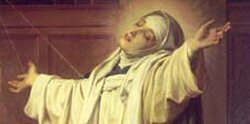HOMILY OF THE HOLY FATHER
JUBILEE OF CONSECRATED LIFE
Wednesday, 2 February 2000
Dear Brothers and Sisters!
1. "There was a man in Jerusalem, whose name was Simeon, and this man was righteous and devout, looking for the consolation of Israel, and the Holy Spirit was upon him.... And there was a prophetess Anna" (Lk 2: 25-26, 36).
These two figures, Simeon and Anna, witnessed the presentation of Jesus at the temple in Jerusalem. The Evangelist stresses that each of them, in his or her way, is a precursor of the event. Both express the longing for the Messiah's coming. Both in some way bear within them the mystery of the temple in Jerusalem. Thus they are both present there - in a way that can be called providential - when Jesus' parents take him to the temple, 40 days after his birth, to offer him to the Lord.
Simeon and Anna represent the expectation of all Israel. It is granted to them to meet the One whom the prophets had foretold for centuries. Enlightened by the Holy Spirit, the two elderly people see the long-awaited Messiah in the Child that Mary and Joseph have brought to the temple as prescribed by the law of the Lord.
Simeon's words have a prophetic tone: the old man looks at the past and foretells the future.
He says: "Lord, now let your servant depart in peace, according to your word; for mine eyes have seen your salvation which you have prepared in the presence of all peoples, a light for revelation to the Gentiles, and for glory to your people Israel" (Lk 2: 29-32). Simeon expresses the fulfilment of the expectation that was his reason for living. The same thing occurs with the prophetess Anna, who rejoices at the sight of the Child and speaks of him "to all who were looking for the redemption of Jerusalem" (Lk 2: 38).
2. Every year a vast throng of consecrated persons assembles at the Tomb of Peter for today's liturgical feast. Today, this throng has become a multitude, because consecrated persons have come here from every part of the world. Dear brothers and sisters, today you are celebrating your Jubilee, the Jubilee of Consecrated Life. I welcome you with the Gospel embrace of peace!
I greet the men and women Superiors of the various congregations and institutes, and I greet all of you, dear brothers and sisters, who have wished to experience the Jubilee by crossing the threshold of the Holy Door in the Patriarchal Vatican Basilica. In you I see all your brothers and sisters throughout the world: my affectionate greeting also goes to them.
Assembled at the Tomb of the Prince of the Apostles in this Jubilee Year, you wish to express with special emphasis the deep bond that links consecrated life to the Successor of Peter. You are here to place upon the altar of the Lord the hopes and problems of your respective institutes. In the spirit of the Jubilee, you give thanks to God for the good he has wrought and, at the same time, you ask his forgiveness for the failings that may have marked the life of your religious families. You are asking yourselves at the beginning of a new millennium about the most effective ways to contribute, while respecting your foundational charism, to the new evangelization by reaching out to the many people who still do not know Christ. With this in mind, your fervent prayer rises to the Lord of the harvest that he will awaken in the hearts of many young men and women the desire to give themselves totally to the cause of Christ and the Gospel.
I gladly join in your prayer. Having been a pilgrim in so many parts of the world, I have been able to appreciate the prophetic value of your presence for all Christian people. Men and women of this generation have a great need to meet the Lord and his liberating message of salvation. On this occasion I am also pleased to note the example of generous Gospel dedication offered by your countless brothers and sisters, who often work in difficult situations. In Christ's name they devote themselves unreservedly to serving the poor, the outcast and the lowly.
Many of them, even in recent years, have paid with the supreme witness of blood for their choice of fidelity to Christ and to man, without surrender or compromise. They deserve the tribute of our admiration and gratitude!
3. Jesus' presentation in the temple sheds particular light on the choice you have made, dear brothers and sisters. Do you too not live the mystery of the expectation of Christ's coming, expressed and as it were personified by Simeon and Anna? Do not your vows express with particular intensity that expectation of meeting the Messiah which these elderly Israelites cherished in their hearts? Old Testament figures standing on the threshold of the New, they reveal an inner attitude that is never out-of-date. You have made it your own, as you look with expectation for the second coming of the Bridegroom.
Eschatological witness is part of your vocation. The vows of poverty, obedience and chastity for the kingdom of God are a message that you proclaim to the world about man's ultimate destiny. It is a valuable message: "Those who vigilantly await the fulfilment of Christ's promises are able to bring hope to their brothers and sisters who are often discouraged and pessimistic about the future" (Vita consecrata, n. 27).
4. "It had been revealed to him by the Spirit" (Lk 2: 26). What the Evangelist said of Simeon can easily be applied to you whom the Spirit leads towards a special experience of Christ. By the renewing power of his love, he wants to make you effective witnesses to conversion, penance and new life.
To have your heart, affections, interests and feelings centred on Jesus is the most important aspect of the gift that the Spirit works within you. He conforms you to the chaste, poor and obedient Jesus. And the evangelical counsels, far from being an impoverishing renunciation, are a choice that frees a person for a fuller realization of his potential.
The Evangelist notes that the prophetess Anna "did not depart from the temple" (Lk 2: 37). The first vocation of those who endeavour to follow Jesus with an undivided heart is "to be with him" (Mk 3: 14), to be in communion with him, listening to his words in constant praise of God (cf. Lk 2: 38). I am thinking at this moment of prayer, particularly liturgical prayer, which rises from so many monasteries and communities of consecrated life in every corner of the earth.
Dear brothers and sisters, make your praise resound in the Church with humility and constancy, and the hymn of your life will echo deeply in the heart of the world.
5. The joyful experience of meeting Jesus, the exultation and praise which flow from the heart, cannot remain hidden. The service given to the Gospel by institutes of consecrated life and societies of apostolic life, in the variety of forms which the Holy Spirit has stirred up in the Church, is always born of an experience of love and a living encounter with Christ. It arises from sharing his efforts and his ceaseless offering to the Father.
Invited to leave everything to follow Christ, you, consecrated men and women, no longer define your life by family, by profession or by earthly interests, and you choose the Lord as your only identifying mark. Thus you acquire a new family identity. The divine Teacher's words apply particularly to you: "Here are my mother and my brethren" (cf. Mk 3: 35). The invitation to renunciation, as you know well, is not meant to leave you "without a family" but to make you the first and distinctive members of the "new family", a witness and prophetic example for all whom God wishes to call and bring into his house.
6. Dear friends, at every moment of your life may the Virgin Mary be close to you as an example and support. Simeon disclosed to her the mystery of the Son and the sword that would "pierce through your own soul also" (Lk 2: 35). Today I entrust to her those of you here and all consecrated persons who are celebrating their Jubilee.
Virgin Mary, Mother of Christ
and of the Church,
look upon the men and women
whom your Son has called to follow
him in total consecration to his love:
may they always let the Spirit
guide them;
may they be tireless in giving of
themselves and in serving the Lord,
so as to be faithful witnesses to
the joy that flows from the Gospel,
and preachers of the Truth
that leads human beings
to the springs of immortal life.
Amen!
--------------------------------------------------------------------------------
Holy Father's greetings at end of Mass
I greet the consecrated persons present on this Jubilee day. I also extend my cordial greetings to the French-speaking pilgrims. May everyone give thanks for the grace of consecrated life! I bless you all.
I warmly welcome the consecrated men and women, and the pilgrims and visitors from the English-speaking countries. I invoke almighty God's blessings and grace upon you so that you may grow in friendship with God, who alone can fulfil the deepest aspirations of the human heart.
I very cordially greet the consecrated men and women who have come to Rome from German-speaking countries to celebrate the Great Jubilee and to renew their vows. May this gathering become a source of inner joy and enthusiasm for their life according to the evangelical counsels.
I extend a heartfelt greeting to the consecrated persons as well as to the Spanish-speaking pilgrims who have taken part in this celebration. With the grace of the Jubilee may you proclaim Christ by your witness of life and your apostolic zeal.
I cordially greet all the orders, congregations, societies of apostolic life and institutes present for the Jubilee of Consecrated Life in Rome. I thank God with you for the gift of your vocation to the consecrated life, which is bearing abundant fruits of holiness and apostolic zeal in our homeland and beyond its borders.
I also greet all the pilgrims who have come to the Eternal City.
 From Vatican Information Service:
From Vatican Information Service:
























